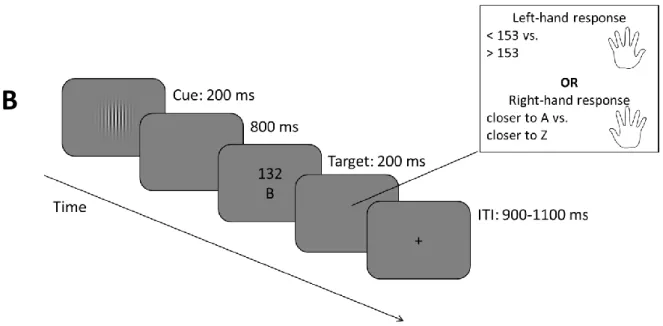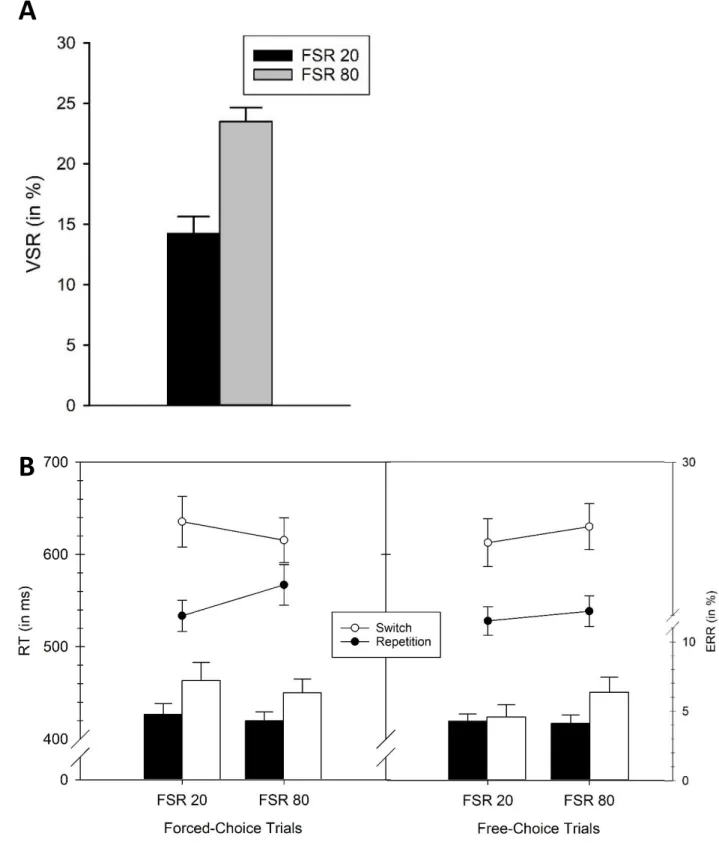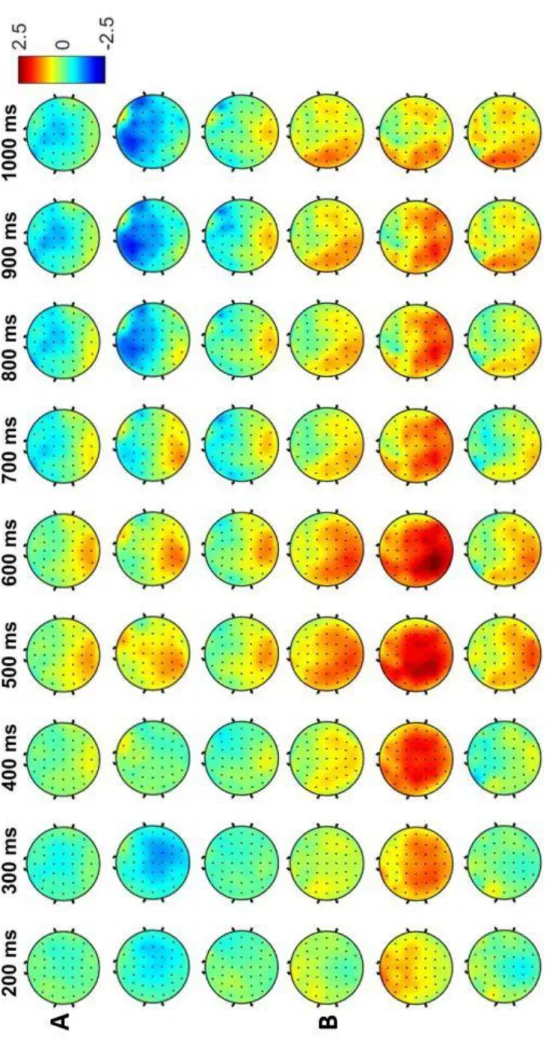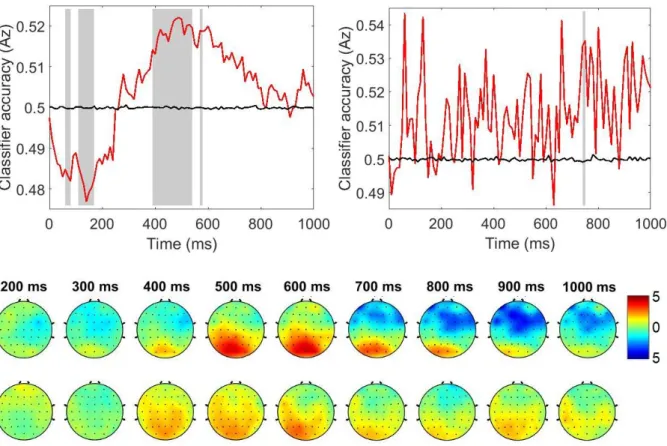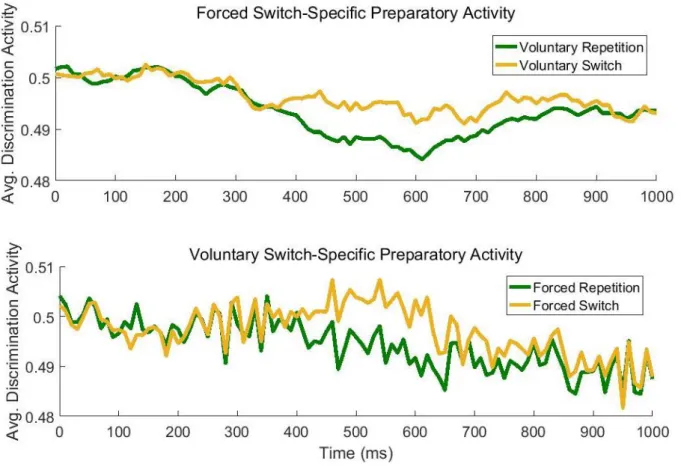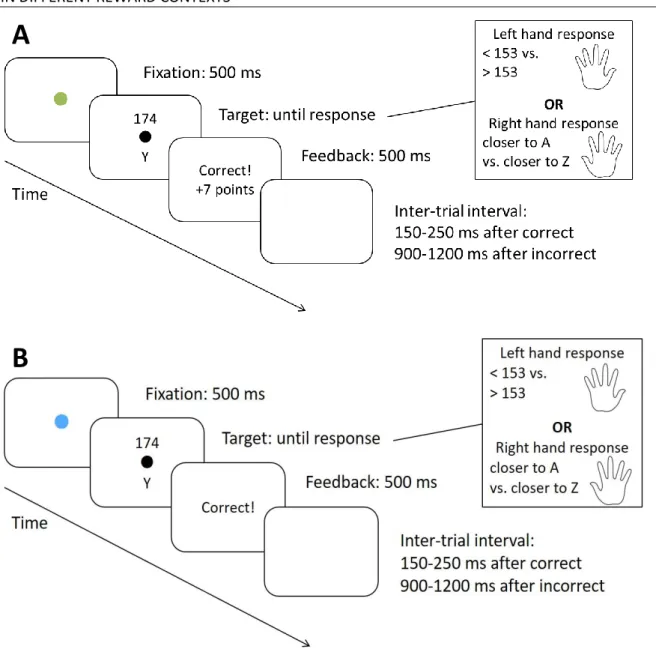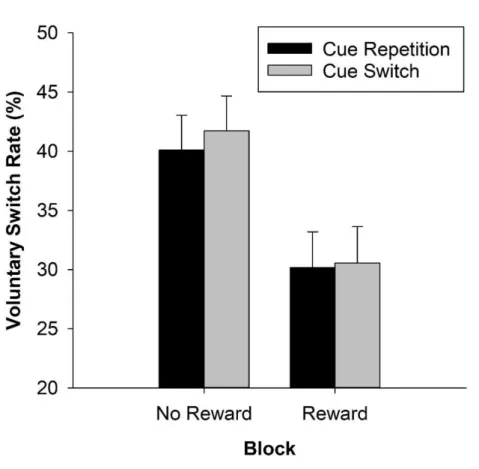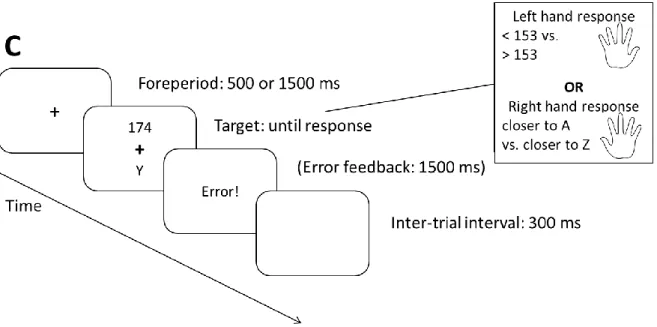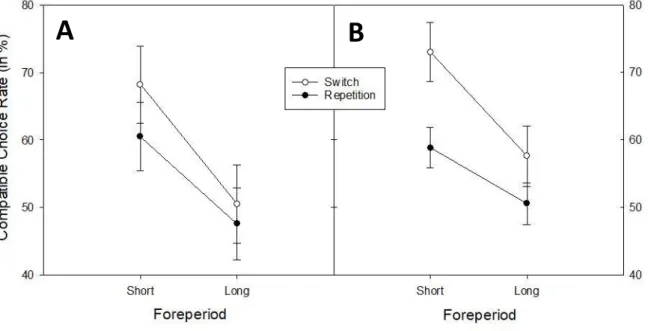Modulation of cognitive flexibility:
Context- and expectancy-based
effects on voluntary task choice
Publikationsbasierte Inaugural-Dissertation zur Erlangung der Doktorwürde
an der Fakultät für Humanwissenschaften der Universität Regensburg
vorgelegt von VANESSA JURCZYK
Regensburg 2020
Gutachterin (Betreuerin): Prof. Dr. Gesine Dreisbach Gutachterin: Prof. Dr. Angelika Lingnau
Acknowledgments
No final project such as a dissertation will be finished in 2020 without reference to the novel Corona virus – though these are trying times, constantly being reminded to #stayathome is indeed quite helpful if that is what you should be doing anyway. Additionally, I had continued professional and personal support, even if it was at times confided to Zoom meetings or phone calls.
First and foremost, I want to express my deepest gratitude to my supervisor Gesine Dreisbach for her guidance, her insightful comments, and for inspiring me in my academic life. She has continued to spark my interest in asking – and answering – psychological questions and allowed me to ever increase my horizon in many ways. I will be forever thankful for the mentoring and assistance she offered whenever needed and for opening up opportunities to walk my own small academic steps.
Further, I would like to thank the whole team of the Allgemeine Psychologie II chair, most and foremost Anja and Kerstin, but also Katrin, Katrina, Carmen, Jonathan, Claudia, Thomas, Johanna, and Felix, for their emotional and professional support and for helping me conquer any obstacles and hardships. You all have created a safe and supportive work environment. I also want to thank all research assistants and students for their help with data collection and to all who participated in my studies.
I would also like to express my thanks to the DFG and the SPP 1772. Having the opportunity to get to know other researchers, attending different conferences or absolving a lab visit at the chair of Marco Steinhauser helped me to adopt a more wide-angle view on multitasking research and on academia in general. I had inspiring and fruitful interactions with a lot of different researchers that all left a very positive and lasting impression on me.
A huge thank you goes to all my friends that accompanied me on a sometimes-stressful journey throughout the last years, and especially through the last months. Having a social network to share worries and happiness, to spend sports sessions or just a relaxed evening was always a most
wonderful resource to me. I particularly want to thank my dearest friend Terry for all the love and support she offers so unconditionally and unfailingly; the same goes out to Michael, Julia, Jan, Franzi, Jelena, and Isabel.
Finally, I would like to express my gratitude to my family for providing a safe haven I can always return to. I would not have finished the last meters of this writing marathon if it were not for my parents, but also my sister Maria who never fail to support, cherish, and care for me. You all never cease to amaze me and I am deeply grateful for having these deep and resilient connections. In the end, it is the people you meet along the way that make the journey count.
Preface
Juggling different tasks at the same time is a vital part of our everyday reality. We constantly have to adjust the balance between several goals at work (Should I prepare the next seminar or edit this paper?), between different social obligations (Should I visit my mother-in-law or my best friend?), or more fundamentally between work and life. Accordingly, the underlying construct of cognitive flexibility is a major field of interest in cognitive psychology. Basic phenomena have now repeatedly been replicated and our understanding of the underlying concepts and models is more and more sharpened. One very fruitful endeavor now is to understand modulating influences on cognitive flexibility. They can tell us something about the limits of cognitive flexibility, but also the way it functions - for example, to which degree it underlies our intentional control. In addition, these modulating influences, investigated under tightly controlled laboratory conditions, are a purposeful step towards the applicability and generalizability of cognitive psychological research.
The main aim of the present thesis is to investigate how different contextual and expectancy- related variables modulate cognitive flexibility. The Introduction is targeted at explaining the relevant theoretical concepts and presenting previous empirical findings that lead up to open questions. Some of these questions will be answered in the currently presented original research. Finally, a General Discussion will present an overarching integration and interpretation of the underlying mechanisms of context- and expectancy-based effects on voluntary task choice.
Content
Acknowledgments ___________________________________________________________ 3 Preface ____________________________________________________________________ 5 ABSTRACT _______________________________________________________________________ 7 PART I – INTRODUCTION __________________________________________________________ 8 A Functional Perspective on Cognitive Control: The Stability-Flexibility Balance __________ 10 The Neuronal Underpinnings of Cognitive Control _________________________________ 14 The (Voluntary) Task Switching Paradigm ________________________________________ 16 Identifying Influencing Factors on the Stability-Flexibility Balance _____________________ 19 PART II – EXPERIMENTAL STUDIES __________________________________________________ 29 STUDY 1: To Switch or to Repeat? – Commonalities and Differences in the Electrophysiological Correlates of Preparation for Voluntary and Forced Task Choices __________________________ 30 STUDY 2: Bottom-Up Influences on Voluntary Task Switching in Different Reward Contexts? 60 STUDY 3: Does Temporal Predictability of Tasks influence Task Choice? ________________ 83 PART III – DISCUSSION __________________________________________________________ 116 Summary of Main Findings __________________________________________________ 117 Overarching Integration: How can Cognitive Flexibility be Modulated? ________________ 119 Combining Different Contextual Manipulations __________________________________ 122 CONCLUSION __________________________________________________________________ 126 References ____________________________________________________________________ 127
ABSTRACT
Performing different tasks in fast succession requires cognitive flexibility. Laboratory research shows that cognitive flexibility under controlled, predefined conditions usually incurs performance costs.
However, less is known about cognitive flexibility that is chosen by the participants themselves – a situation that is not only relevant for our understanding of basic underlying processes, but is especially important concerning the practical implications of psychological research. What are beneficial conditions for deliberate cognitive flexibility and what are their limitations? The current PhD project aims to tackle these questions by investigating how voluntary task switching is influenced by (a) the context in which it occurs (the ratio of forced switches), (b) the reward expectancy within this context, and (c) the temporal predictability of the tasks themselves.
Addressing the first question, we compared electrophysiological preparatory activity in blocks of randomly intermixed voluntary and forced task switching trials to identify shared vs. unique preparation stages. Most importantly, a shared process seems to lie in a task-set reconfiguration stage, whereas task-set updating is more or less involved depending on the forced-choice context.
Regarding the second question in focus, we de-confounded reward prospect and cue changes by using meaningless cues and blocked reward prospect. In blocks of high reward prospect, voluntary switch rate was globally decreased. Irrelevant cue changes had no impact on the deployment of deliberate flexibility. Finally, with respect to the third question under scrutiny, we found that participants’ voluntary task choice was influenced by the foreperiod-task contingencies implemented in forced-choice trials, particularly so on switches.
In sum, motivationally relevant (reward prospect) or predictive (forced-choice context, time- based task expectancy) contextual information can have marked effects on voluntary task switching, whereas meaningless (even if salient) changes such as task-irrelevant cues reflect a limit to these context-driven effects. The results are discussed against the background of current theories on cognitive control, with a special emphasis on the flexibility-stability balance of cognitive control.
PART I –
INTRODUCTION
“The myth of multitasking”1
“Think you’re multitasking? Think again”2
If you search for the term ‘multitasking’ on any search engine, you will find a myriad of newspaper articles and blog entries informing you that multitasking of any kind is costly, inefficient, and generally leads to worse performance than if one performed each task on its own. Even if you are just rapidly switching between tasks, but at each time point focus on just one – say, you are writing an article and stop to check an incoming e-mail as soon as it pops up – the multitasking cost still applies. According to the articles, the best solution is to first finish one task before turning to the other.
Are the authors right? Scientific research of the last two and a half decades on dual-tasking and task switching agrees on one unfailingly present phenomenon: To do two tasks at the same time, or even just rapidly switching between them, is costly, slower, and more error-prone than performing just one task at a time (Monsell, 2003; Pashler, 1994). Even when participants can decide for themselves, they usually decide to repeat tasks whenever possible (Arrington & Logan, 2004; Kessler, Shencar, & Meiran, 2009). So in short: Multitasking is difficult and we prefer to avoid the associated costs.
But that is just one side of the story. Multitasking requirements have been increasing in recent years, especially in the workplace and in communication (González & Mark, 2004; Lohmann- Haislah & Schütte, 2013). This development does not seem to be coming to an end soon as it is tightly linked to new technologies and digital media: In younger generations – such as generation Z or Alpha – consuming more than one type of media at a time is the rule, not the exception (Duff & Segijn, 2019; Voorveld, Segijn, Ketelaar, & Smit, 2014). In leadership positions, multitasking is an essential part of the job, and success is built on the ability to work on several tasks and quickly shift between
1 Napier (2014), Goman (2011), Willingham (2019)
2 Hamilton (2008)
them depending on current priorities (Tobak, 2011). In an even greater context, cognitive flexibility has been named one key factor for mental health (Kashdan & Rottenberg, 2010).
To me, the most important argument, though, is that multitasking is inevitable. Whether it is good or bad, it is a vital part of our everyday life. This seems to be even more the case for the generations to come. It is therefore important to find circumstances that are helpful to multitasking.
This PhD project thus focused on different factors influencing the flexible allocation of cognitive control, or more generally, on flexibility in action control. What are beneficial conditions for deliberate cognitive flexibility and what are their limitations? The current thesis aims to tackle these questions by investigating how voluntary task switching is influenced by (a) the forced-choice context, (b) the underlying reward structure of the tasks, and (c) time-based task expectancy. By tackling the question at hand from various angles, we are not only able to investigate overarching functional principles, but also provide a steppingstone towards generalizability and ecological validity of multitasking research.
Let me start with a brief overview of the conceptual landscape in which we are moving, explaining the term cognitive control, how it is involved in task performance, and how its functional principles can be pinned down to a stability-flexibility balance. I will then go on with a short review of the experimental paradigm employed – the task switching paradigm and its voluntary variant – before turning to previous literature on context- and expectancy-based effects on cognitive flexibility.
A Functional Perspective on Cognitive Control: The Stability- Flexibility Balance
To understand the mechanisms behind successful multitasking, we first have to understand what processes determine successful task- or goal-directed behavior in general. To act in a goal- directed way, especially in the face of counteracting habitual and automatic response tendencies, cognitive control is required (Goschke, 2003). Cognitive control is needed to act in accordance with superordinate goals or tasks, to inhibit habitual or impulsive but non-conducive response tendencies,
and to maintain goals in the face of distraction (Banich, 2009; Goschke, 2013; Miller & Cohen, 2001).
Cognitive control requires active maintenance of task-relevant representations, but also the flexibility to update these representations whenever the current goal is no longer rewarding or appropriate.
For a long time, this action control has been viewed to be dependent on the activity of one control unit. That is, behavior was strictly dichotomized into fast, efficient, automatic (sub-conscious),
“unwilled” behavior and slow, “willed” behavior under conscious control (Ach, 1910; James, 1890).
In later investigations, Shiffrin and colleagues (Atkinson & Shiffrin, 1968; W. Schneider & Shiffrin, 1977; Shiffrin & Schneider, 1977) further specified that controlled as compared to automatic processes are much more susceptible to interference, can be executed only serially, and rely on a capacity-limited central executive. Hence, they maintained the dichotomy between controlled,
“willful” behavior and automatic processing. Even though these models do not rely on the philosophical term of “free will”, simply using a more mechanistic and depersonalized name (“control unit”) is still shortsighted (Goschke, 2003; Hommel, 2015). How is the assumed singular control unit in itself controlled? Who controls the controller? At some point, an inexplicable “homunculus” still has to come into play as a non-measurable, non-materialistic entity that controls the control unit, the supervisory attentional system, the use of cognitive control (Miller & Cohen, 2001; Norman &
Shallice, 1986).
Therefore, biologically plausible cognitive control models that incorporate the assumption of a deterministic, neuronally embedded controller have to assume some sort of self-regulatory control mechanism. Indeed, recent theories have started to withdraw from the strong dichotomy between bottom-up and top-down processing (Berridge, 2004; Goschke, 2013; Hommel, 2015). To allow for self-regulation, they incorporated a reinforcement learning mechanism that is relevant not only to basic processing, but also to higher-level goal striving processes (Berridge, 2004; Holroyd & Yeung, 2012; Inzlicht, Schmeichel, & Macrae, 2014; Shenhav, Botvinick, & Cohen, 2013; Vassena, Deraeve, &
Alexander, 2017). This reinforcement learning mechanism allows the control system to regulate itself based on expected and actual outcomes. The main difference, then, between arguably more
controlled and arguably more automatic behavior can be found in the recency of acquisition of S-R relationships and hence their familiarity (Hommel, 2015): Whereas “automatic” processes depend on S-R links that have been acquired much earlier, “controlled” behavior is driven by stimuli that have been instructed or acquired only recently. Indeed, the same processes that subserve goal-directed,
“willed” behavior in one situation can come into conflict with it in another. The selection and subsequent pursuit of goals is driven by the same associative learning mechanisms as stimulus-driven behavior (Braem & Egner, 2018) and depends on a computed expected value of control (Kool &
Botvinick, 2014; Kool, Shenhav, & Botvinick, 2017; Shenhav et al., 2013; Shenhav et al., 2017). It incorporates incentives provided by the task and the importance of goal achievement as benefits, while costs enter the computation as the required intensity of control and the subjective cost of effort. The output can be seen as the currently optimal value for control allocation. One exemplar for how this computation can be conceptualized and neuronally embedded is provided in the expected value of control theory by Shenhav et al. (2013; see also Kool et al., 2017; Shenhav, Cohen, &
Botvinick, 2016), in which the authors argued that these input variables are integrated to compute expected utility, or, as the authors put it, a “willingness-to-pay signal in the currency of cognitive control” (p. 230). At the same time, prediction errors are computed that feed forward into subsequent computations and ensure a constant adjustment to current goals and environmental demands.
In recent theoretical frameworks (Dreisbach & Fröber, 2019; Goschke, 2013; Hommel, 2015), cognitive control is conceptualized as a number of control parameters that act on a dynamic and adaptable stability-flexibility balance: In some situations, stability is required, such as when a current goal or task has to be shielded against distractions. In other situations, however, goal-directed behavior depends on a flexible shift between alternatives, for instance when switching between tasks. Adaptive and successful goal-directed behavior should be characterized by a strong shielding against distraction, but at the same time, meaningful changes in the environment or the task should be faced with a swift change in behavior and priorities. If you are writing your thesis, you have to
suppress the urge to look at the phone ever so often. However, if writing a specific chapter is no longer productive, going back to other chapters or checking your literature summaries is indicated.
It is important to note that stability and flexibility are necessarily antagonistic – a more stable cognitive control mode inevitably goes along with less flexibility, because focusing on the task at hand requires shielding from currently irrelevant (but potentially important) information. At the same time, increased flexibility also goes along with an increase in distractibility. To sum up, successful goal-directed behavior depends on the swiftly adapting stability-flexibility balance of cognitive control. Too rigid stability, as well as too fallible flexibility, will result in maladaptive perseveration or distractibility, as seen in mental disorders such as ADHD (Karch et al., 2014). Depending on the context, this balance has to be constantly readjusted. In the deliberations of Goschke (2013), a very fitting summary can be found:
Contrary to the intuitive impression that intentions are immediate ‘triggering’ causes of actions, […] intentions play a much more indirect role and can be conceived of in terms of internal constraints that ‘preconfigure’ response dispositions and thereby bias which responses are subsequently activated by stimuli. (p. 409)
Hence, task performance in multitasking situations requires constant readjustments on the stability-flexibility balance: If a task is performed continually or repeatedly for some time (e.g., writing an article), a stable cognitive control mode is indicated, because in this mode information from other tasks (say, answering incoming e-mails) or completely irrelevant information should be relatively more prohibited from interfering. On the other hand, task switches (such as interrupting the writing process to answer a much-awaited phone call from a funding agency) require an efficient and swift disengagement and the rapid activation of the new task, that is, they profit from a flexible cognitive control mode.
The Neuronal Underpinnings of Cognitive Control
The question arises which mechanisms allow for this constant readjustment of control along a stability-flexibility axis. Almost all decision-making theories acknowledge the simultaneity problem (see e.g., Bogacz, 2007; Kurzban, Duckworth, Kable, & Myers, 2013; Oberauer & Kliegl, 2006;
Oberauer, Souza, Druey, & Gade, 2013): Some computational mechanisms, especially those associated with working memory or central response selection processes (Oberauer et al., 2013;
Oberauer & Kliegl, 2006; Pashler, 1994), can be deployed for only a limited number of simultaneous items or tasks at any given moment. Therefore, multiple representations compete at any given point in time, and cognitive control mechanisms have to implement the appropriate selection, updating, or maintenance of an alternative.
A critical functional hub in this respect, specifically for task-switching situations, is procedural working memory (Kessler, 2017; Oberauer et al., 2013; Rac-Lubashevsky & Kessler, 2016) which holds procedural representations – in the present case, task sets – in an activated state. It consists of three components: An activated part of long-term memory (in a task-switching situation, this would mean all currently relevant tasks, stimuli, and responses), a central component called the bridge (capacity- limited in nature), and the response focus (hence, the single response selected for execution). The central component is of main interest here: Because of its limited capacity, tasks compete for access to this region. Whenever a task set becomes the focus of the bridge, procedural representations of stimulus-response rules are readily available. A gating mechanism controls whether or not the information currently held active in the bridge is updated or not (Kessler, 2017; Rac-Lubashevsky
& Kessler, 2016). Opening the gate and updating information are costly processes, and residual bindings in working memory or activated long-term memory can interfere with current task performance. However, this model makes no predictions how the decision as to whether the gate to the bridge should be opened or closed is managed. In that way, it merely serves as a canvas, a sort of functional background information; it does not explain who paints the picture, that is, how the balance between maintenance and updating is regulated in the short or long term.
Here, insights from neuroscientific research are of help putting an emphasis on control loops involving the anterior cingulate cortex (ACC). The ACC is suggested to learn the value of response options and feed them into subsequent controlled behavior (Holroyd & Yeung, 2012; Kennerley, Walton, Behrens, Buckley, & Rushworth, 2006). Especially the dorsal portion of the ACC (dACC) integrates information to determine subsequent control allocation by computing the expected value of control (Shenhav et al., 2013) and monitoring subsequent behavior by computing prediction errors.
The specific regulation according to the expected value of control is carried out by the lateral prefrontal cortex (PFC) (Kouneiher, Charron, & Koechlin, 2009), especially the dorsolateral portion (dlPFC), together with associated structures in the basal ganglia and dopaminergic and noradrenergic nuclei in the brainstem. The active maintenance of task representations biasing the posterior cortex is ascribed to the lPFC (Miller & Cohen, 2001). One mechanism for this active maintenance may lie in recurrent excitatory connectivity between active bistable neurons in the PFC, which can create a sort of “attractor” state (O'Reilly, 2006). These bistable neurons, if sufficiently stimulated, stay active through gated ion channels (e.g., the NMDA channel) for several hundreds of milliseconds, thus arguably supporting cognitive stability (cf. Goschke & Bolte, 2014).
In contrast, widespread connectivity with subcortical structures subserves a gating function for the updating of task representations in the PFC (O'Reilly, 2006; O'Reilly & Frank, 2006). Hence, these connections may reflect the neuronal hub for adjustments on the stability-flexibility balance.
This gating mechanism can be open, which allows for a rapid updating of active representations in the PFC. A closed gate, on the other hand, leads to stable maintenance of the current activity pattern.
Several structures and connections have been proposed for this gating mechanism, most importantly connections with dopaminergic structures in the ventral tegmental area (VTA; for reviews see Cools, 2016; Cools & D'Esposito, 2011; Durstewitz & Seamans, 2008). It has been suggested that the relationship between the stability of working memory content and DA levels is characterized by an inverted U-shaped function. Both suboptimal and supraoptimal levels of dopamine in the PFC lead to destabilization (Fallon, Williams-Gray, Barker, Owen, & Hampshire, 2013). At the same time, different
classes of DA receptors (D1 and D2) are suggested to subserve different control states (Durstewitz
& Seamans, 2008). For one, DA D1 receptor activation, especially present in the PFC, yield a stabilizing effect on working memory content in the PFC, among others mediated by NMDA channel activation.
Against this, D2 receptor activation aids updating processes. Whereas this D1/D2-dependent stability-flexibility modulation has quite broad and diffuse effects, activity in direct pathway “Go”
neurons and indirect pathway “No Go” neurons in the basal ganglia enables selective maintenance or updating of only some regions of the PFC (O'Reilly, 2006). This is not to be viewed as mutually exclusive, though. While “Go” pathways largely depend on DA D1 neurons, “No Go” pathways depend on DA D2 neuron activity. Similarly, Cools (2016) suggests that DA activity in the striatum aids cognitive flexibility, and opposed to that, DA activity in the PFC helps cognitive stability. At the same time, DA neurons in the striatum largely have D1 receptors, whereas DA neurons in the PFC have D2 receptors. Relatedly, noradrenergic projections between the locus coeruleus (LC) and the neocortex have been proposed to mediate performance on an exploration-exploitation axis (Aston-Jones &
Cohen, 2005), which is closely linked to the concepts of flexibility or stability, respectively.
To sum up, current neuroscientific research indicates that dACC and lPFC are prominently involved in the specification of a control signal – where and whether to allocate control – and the subsequent regulation of the task-relevant brain circuits. The updating and maintenance of information – or, to use a more concept-based language, cognitive flexibility and stability – are mediated via widespread dopaminergic and noradrenergic connections between the brainstem, the basal ganglia, and the PFC.
The (Voluntary) Task Switching Paradigm
Before turning to a closer description of the independent variables under scrutiny, I will first give an overview of the experimental paradigm employed. In all of the presented experiments, the task switching paradigm was used (Grange & Houghton, 2014; Kiesel et al., 2010; Monsell, 2003;
Vandierendonck, Liefooghe, & Verbruggen, 2010). In this experimental setup, participants are
confronted with two (or more) different tasks. On each trial, the task can either stay the same as in the previous trial (repetition) or change (switch trial). The tasks, oftentimes categorization tasks, can be contingent on different features of one so-called bivalent stimulus. One example of such a bivalent stimulus is a digit that can either be classified according to its magnitude or its parity (Kiesel et al., 2010). Alternatively, two univalent stimuli can be used for the two tasks. An exemplar would be a number magnitude task and a letter alphabet task (e.g., Fröber & Dreisbach, 2016b). In a variant of the standard design, participants are presented with a cue that announces the to-be-performed task (Kiesel et al., 2010; Meiran, 1996; Monsell, 2003). Either way, in the standard task switching design, participants are told whether to repeat or switch from the previously performed task, resulting in a comparison of task switch and task repetition trials. Behaviorally, participants display switch costs, that is, they make more errors and are slower in switch relative to repetition trials.
Opposed to this, in the voluntary task switching paradigm the participants decide themselves which task to perform on each trial (Arrington & Logan, 2004). This means, the participants have control over whether they repeat the task from the previous trial or switch to the other task.
Therefore, ecological validity is increased compared to the standard task switching paradigm (Arrington & Logan, 2005; Demanet & Liefooghe, 2014; Vandierendonck, Demanet, Liefooghe, &
Verbruggen, 2012). On top of investigating switch costs in performance, the voluntary task switching paradigm allows to investigate participants’ voluntary task choice. One important dependent variable here is the voluntary switch rate (VSR), which is the number of trials in which participants choose to switch between tasks. In addition to the switch costs on performance, a repetition bias can be found in the VSR, that is, participants typically prefer to repeat tasks over switching between them. This is especially noteworthy because participants are typically instructed to perform both tasks equally often and in random order (Arrington & Logan, 2004, 2005).
What control processes are involved in forced and voluntary task switching? Here, the notion of task set is helpful. It is generally assumed that participants usually adopt a task set to perform a task successfully (Dreisbach, 2012; Dreisbach & Haider, 2008, 2009; Monsell, 2003). In other words,
in response to or in preparation for a task the relevant stimulus-response rules of a task have to be activated or reconfigured, together with associated adjustments in attention and response-related processing (Logan & Gordon, 2001; Oberauer et al., 2013; Vandierendonck et al., 2010). One prominent class of theories assumes that switch costs largely reflect the time that control processes need to reconfigure a task set (Rogers & Monsell, 1995; Rubinstein, Meyer, & Evans, 2001), allowing to actively overcome carryover activation from previous task-set states (Allport, Styles, & Hsieh, 1994;
Meiran, Kessler, & Adi-Japha, 2008). Because switch costs can be reduced, but not eliminated with increasing preparation time (Monsell & Mizon, 2006), some authors suggest that a part of this task- set reconfiguration process can be prepared in advance (termed endogenous component of task-set reconfiguration), whilst another part cannot (exogenous component of task-set reconfiguration; cf.
Monsell, 2003). Still other researchers (e.g., Arrington & Logan, 2005; Arrington, Reiman, & Weaver, 2014; Demanet & Liefooghe, 2014) propose that the VSR may be a more adequate measure of control, as it is less susceptible to contextual information such as associations between tasks and stimulus features, and under tighter control of the participants themselves.
Another set of theories assumes that processes on switches are entirely the same as processes on repetitions – except for the fact that on switches, they take longer (e.g., Meiran, 2000).
In studies where task predictability of cues was varied, similar effects were obtained for switches and repetitions: Higher predictability led to slower reaction times; no modulation of switch costs was found (Dreisbach, Haider, & Kluwe, 2002). That is, an updating process of the currently active task set – depending on the predictability of the cue – was equally engaged in switches and repetitions. This account is corroborated by recent electrophysiological evidence indicating a similar task-preparatory process in both switches and repetitions (M. Steinhauser, Maier, & Ernst, 2017; R. Steinhauser &
Steinhauser, 2019). One overarching reason for the emergence of switch costs and the repetition bias hence may be that task-set updating is a more time-consuming process on task switch trials (Dreisbach, 2012).
Either way, both cognitive stability and cognitive flexibility are required in task switching (Dreisbach & Wenke, 2011): To perform a task repetition effectively, the task rules of the second task have to be shielded as much as possible, therefore a stable cognitive control mode is beneficial. On the other hand, a task switch requires flexibility, in the sense of efficient disengagement from the previous task and rapid activation of the now-required task. As a task switch in comparison to a task repetition (in terms of reaction times, error rates, and the VSR) is usually associated with costs, it is standing to reason that cognitive stability is the default option. Given that many everyday situations require cognitive flexibility, it is of paramount importance to identify variables that shift the stability- flexibility balance towards the flexible pole. Note that we classify conditions that specifically aid task switches – either in the form of less switch performance costs or a high VSR – as those enhancing cognitive flexibility.
Identifying Influencing Factors on the Stability-Flexibility Balance
Several findings indicate that both forced and voluntary task switching behavior is susceptible to contextual influences. For example, a series of studies argue that cue- and task-related memory processes play a role in the emergence of switch costs and the repetition bias (Altmann & Gray, 2008;
Koch & Allport, 2006; Koch, Prinz, & Allport, 2005; Logan & Bundesen, 2003; Mayr & Kliegl, 2003;
Waszak, Hommel, & Allport, 2005). In voluntary task switching specifically, the rate of voluntary switches can be decreased with high working memory load (Demanet, Verbruggen, Liefooghe, &
Vandierendonck, 2010) or with short response-stimulus intervals (Arrington & Logan, 2004, 2005). In addition, relevant changes in the experimental situation such as variations of the stimulus or the offered reward have an impact on the VSR. Mayr and Bell (2006) could show that a change in stimulus promotes a change in the task, while a stimulus repetition usually also results in a task repetition.
Even though these and other (Yeung, 2010) findings suggest that both forced and voluntary task switching is susceptible to bottom-up influences, the extent as well as the direction of this influence
can differ considerably. Yeung (2010) could show that tasks that vary in task difficulty result in asymmetrical switch costs (larger costs when switching to the more difficult task), but a surprising task bias towards the more difficult task was found (participants choose to do the more difficult task more frequently than the easier task). Arrington and Yates (2009; see also Orr & Weissman, 2011) yielded evidence indicating that individuals differ in terms of their reliance on exogenous factors for task choice: The voluntary task switching paradigm thus enables the investigation of interindividual differences that may not be visible when investigating performance measures alone (see also Jurczyk, Fröber, & Dreisbach, 2018).
Despite these first promising research avenues, literature specifically investigating how self- chosen flexibility can be enhanced is rather sparse. The current PhD project therefore is aimed at filling this gap: For one, first findings on the flexibility-inducing effects of forced-choice context and reward prospect will be re-examined and extended, allowing to answer the question of how replicable and generalizable these effects are. In addition, a third factor (temporal predictability), which has been shown to affect forced task switching performance, will be applied in a voluntary task switching environment. Overarchingly, the present studies employ designs that are – in comparison to previous studies – well suited to compare task performance (RTs and ERRs) to task choice (VSR, task biases) measures and forced-choice to free-choice environments.
Influence of the context on deliberate cognitive flexibility: How and when does the forced-choice context influence voluntary task switching?
An incidental finding in a previous study (Fröber & Dreisbach, 2016b, Exp. 1-4) spurred interest in the effect of a mixture of forced and voluntary task switching trials: In four experiments, Fröber and Dreisbach randomly combined a high ratio of forced-choice and a small number of voluntary trials within blocks. Even though participants were not explicitly instructed to do so, they voluntarily switched between tasks to a surprisingly high degree (VSR between 30 and 40 %). This is especially astonishing because, as mentioned earlier the VSR is usually very low under these
completely unrestricted conditions (e.g., 9-13 % in Kessler et al., 2009). Two aspects of the experiments of Fröber and Dreisbach offer an explanation for this finding: One aspect is the manipulation of the reward prospect, which will be introduced below, the other aspect are the intermixed forced-choice trials. Fröber and Dreisbach (2017) specifically investigated voluntary task choice in such a hybrid design: In two experiments, forced and voluntary trials were randomly combined within each experimental block. Using univalent stimulus material, a trial presenting just one stimulus constituted a forced-choice trial, whereas two presented stimuli (one for each task) marked a voluntary trial. In a first study, the ratio of forced to voluntary trials (25:75, 50:50, 75:25) was manipulated between participants. And indeed, the higher the number of forced choices, the higher the ratio of voluntary switches. Next, the authors pursued the question whether this was due to the number of forced choices per se, or merely due to a subgroup of these trials, namely, forced switches. That is, does the mere act of being forced frequently to do one or the other task induce a higher flexibility, or does only frequent forced switching elicit such a global flexibility-inducing effect?
Note that in this first experiment, within the forced-choice trials, the ratio of forced repetitions to forced switches was set to 50 %. Hence, in a second experiment, Fröber and Dreisbach orthogonally manipulated the ratio of forced-choice to free-choice trials (25:75 and 75:25), and, within the forced- choice trials, the forced switch rate (25 % and 75 %). Again, they used a between-subjects design, which resulted in four experimental groups. The main effect of forced-choice ratio was again confirmed (higher VSR with a higher forced-choice ratio). This effect was qualified by an interaction with forced switch rate: Whereas the two groups with a 75:25 ratio of forced-choice to free-choice trials voluntarily switched tasks more often than the two 25:75 groups, a flexibility-inducing effect of a high forced switch rate only showed up with a sufficiently high number of forced-choice trials per se, that is, only in the 75:25 forced-choice to free-choice trials ratio group. On a theoretical level, Dreisbach and Fröber (2019) suggested that the requirement to switch tasks frequently leads to both tasks being held active in working memory. This is even more so, the more often task choice is not determined by the participants themselves (in free-choice, or voluntary trials), but by the
experimenter (in forced-choice trials). This increased task uncertainty results in a global bias toward flexibility. This global bias is suggested to only aid the flexible shift between the two tasks at hand, as only these are held in a more active and readily usable state in working memory. Putting this theoretical hypothesis to a test is one of the aims of the current PhD project.
To investigate switch-specific processes in forced and voluntary task switching in conjunction with a manipulation of the forced switch rate, especially in preparation to the stimulus, we made use of the excellent temporal resolution of electroencephalographic (EEG) recordings. To obtain EEG data, electrodes are mounted onto the scalp. The signal the EEG represents usually comes from dozens of different neural sources of activity, but mostly postsynaptic potentials of large numbers of similarly oriented cortical pyramid cells (Luck, 2005). When investigating event-related potentials (ERPs) as done in the present case, electrophysiological activity in response to a certain stimulus is averaged across many trials – hence canceling out most of the noise. The resulting averaged ERP waveforms can be analyzed regarding the presence or absence of characteristic positive or negative voltage deflections, depending on the specific condition. An important technique in this regard is to compute difference waves: Here, we were specifically interested in the differential activity between task switches and repetitions. In past investigations, the switch-repeat difference wave showed two characteristic deflections, especially in a forced task switching context (for a review see Karayanidis
& Jamadar, 2014): A switch positivity maximally around 400 to 600 ms after a task cue can be found at centro-parietal sites. Its magnitude varies with switch performance (as measured in RTs; e.g., Lavric, Mizon, & Monsell, 2008), but also with switch demands (Elchlepp, Lavric, Mizon, & Monsell, 2012), and has been interpreted as a specific index for task-set reconfiguration. It is often accompanied or followed by a later negative-going deflection in more frontocentral electrode sites which is usually stronger for repetitions. This pre-target negativity is discussed to reflect general task- preparatory attentional enhancements (Jamadar, Michie, & Karayanidis, 2010).
The current Study 1 conducted in collaboration with Robert Steinhauser and Marco Steinhauser from the Catholic University Eichstätt-Ingolstadt is aimed at investigating preparatory
(switch-specific) activity prior to forced and voluntary choice trials. Given that previous findings on the electrophysiological signature of voluntary task switching are highly diverse and even contradicting (Chen & Hsieh, 2015; Poljac & Yeung, 2014), the proposed hybrid design may be helpful in identifying shared and distinct processes in forced and voluntary task switching. It may also be of use to link specific components and underlying processes with the switching requirements per se and the particular requirements associated with a voluntary task switch. A second aim of this study is to investigate the effects of forced switch rate (varied between 20 % and 80 % between blocks) on preparatory indices. In each block, 50 % forced and 50 % voluntary trials were presented in random order (the previously introduced hybrid design by Fröber & Dreisbach, 2016b, 2017). In order to control the onset of preparatory processes and to increase signal-to-noise ratio, cues (announcing one of two tasks in the case of a forced-choice trial, or a voluntary choice) were shown before each target. Finally, in a logistic regression-based multivariate pattern analysis (R. Steinhauser
& Steinhauser, 2019; M. Steinhauser & Yeung, 2010, 2012), we extracted spatiotemporally defined activity that maximally discriminated switch from repetition trials. For one, this allows to examine switch-specific ERP potentials in the EEG, but most importantly, we can explore more directly which portions of the preparatory activity reflect a common process in forced and voluntary task switching.
Influence of reward prospect on deliberate cognitive flexibility: Is the sequential reward effect due to the perceptual cue change or the reward change?
The “orienting and invigorating impact . . . of prospective reward” (Botvinick & Braver, 2015, p. 84) has been suggested as a working definition of motivation. In the same sense, we wanted to investigate motivational effects on the exertion and mode of cognitive control by comparing different reward contexts. It should be noted that the reward prospect effect is to be differentiated from reward reception effects (for a review see e.g., Notebaert & Braem, 2016), but also from other, related terms such as effort that describes the task-difficulty related increase in the engagement of capacity-limited, controlled processes (Inzlicht, Shenhav, & Olivola, 2018; Shenhav et al., 2017). In
our Study 2, we examined the effects of performance-contingent reward prospect, which can be demarcated from those of noncontingent reward prospect (Fröber & Dreisbach, 2016a). Indeed, reward reception, noncontingent reward prospect as well as performance-contingent reward have been investigated in the context control. Performance-contingent reward prospect, in particular, has been found to increase stability and task-related processing in working memory (Jimura, Locke, &
Braver, 2010), dual-tasking (Fischer, Fröber, & Dreisbach, 2018), or cue maintenance (Fröber &
Dreisbach, 2014; Hefer & Dreisbach, 2017, 2020).
However, flexibility-inducing effects of performance-contingent reward prospect have been reported as well. Shen and Chun (2011) were the first to investigate the critical role of immediate reward history systematically. Over three experiments, reward prospect was varied randomly between high and low magnitude. Hence, four different reward sequences could be investigated depending on the reward prospect in the current trial as compared to the previous trial: It could either stay on a high or low level (remain-high and remain-low condition) or change (increase and decrease condition). Shen and Chun examined the impact of these four reward sequences on forced task switching behavior. Most importantly, they found that switch performance (both in absolute switch RT and the switch-repeat difference in RTs) benefitted from increasing reward prospect. This fits with findings by Kleinsorge and Rinkenauer (2012) who could show that if reward prospect is randomly changed between no reward prospect vs. reward prospect, switch costs can be specifically reduced in reward trials that were preceded by a no-reward trial. This is especially remarkable because several previous studies which globally incentivized performance did not find any switch- specific effect of reward prospect (Capa, Bouquet, Dreher, & Dufour, 2013; Dreisbach et al., 2002;
Nieuwenhuis & Monsell, 2002; Savine & Braver, 2010).
Fröber and Dreisbach (2016b) pursued the question whether the VSR would equally be influenced by the reward sequence. In a first experiment, they compared how the VSR differed between unchanged high reward prospect and increasing reward prospect. And indeed the VSR was higher with increasing reward prospect than with unchanged high reward prospect. In subsequent
experiments, they confirmed that this was not due to the mere physical change in the cue appearance: Even if several colors (Exp. 2) or shapes (Exp. 3) were associated with each reward magnitude, allowing for a reward cue switch even in reward-unchanged conditions, the flexibility- enhancing effect of increasing reward prospect showed up. In two final experiments, the authors additionally investigated decreasing and unchanged low reward prospect: To summarize, only unchanged high reward prospect continued to result in increased stability, whereas both increasing and decreasing reward prospect went along with more voluntary switches. The VSR following unchanged low reward prospect was of intermediate height.
As suggested by the two experiments using more than one cue per magnitude (since confirmed in several studies, Fröber, Pfister, & Dreisbach, 2019; Fröber, Pittino, & Dreisbach, 2020;
Fröber, Raith, & Dreisbach, 2018; Jurczyk et al., 2018), this sequential reward effect is not due to simple perceptual priming effects: Mere physical repetition of the cue is not the main reason for the sequential reward effect. But does it not play any role at all?
Experiments 2 and 3 investigated the effect of irrelevant cue switches on voluntary task switching in high and low reward contexts. The VSR is known to be influenced by the repetition vs.
switch of low-level features (Mayr & Bell, 2006) if these features carry relevant task information. A study on invertebrates (Czaczkes, Koch, Fröber, & Dreisbach, 2018) has shown that ants will switch between behaviors more often if irrelevant cues change, but only if they are presented in a high- reward context. On the other hand, if reward prospect is changed sequentially (Fröber et al., 2018;
Fröber & Dreisbach, 2016b), both an increase and a decrease result in a higher VSR. The current design will use randomly changing irrelevant cues and fixed reward prospect within blocks, thereby allowing to differentiate between the two possibilities: If mere cue change triggers a higher VSR, we should find a main effect of the irrelevant cue changes. Whether or not this is influenced by the reward prospect will further our understanding of reward-induced effects on task performance and task choice. In addition, the current study 2 allows to examine the long-term nature of unchanged reward prospect effects.
Influence of temporal predictability on self-chosen cognitive flexibility: Does temporal predictability of tasks influence task choice?
The first two studies were aimed at investigating the effects of context and reward prospect.
In a last study, we looked at how characteristics of the task and trial structure influence voluntary flexibility, in particular regarding the temporal structure. It has been shown that participants’ task performance can adapt to different temporal correlations: If certain durations are paired with certain tasks, performing these tasks will be faster in predicted time-task conditions than unpredicted ones.
More specifically, Aufschnaiter and colleagues (Aufschnaiter, Kiesel, Dreisbach, Wenke, &
Thomaschke, 2018; Aufschnaiter, Kiesel, & Thomaschke, 2018) used two different foreperiods in a forced task switching design, 500 ms and 1500 ms. Unbeknownst to the participants, one of the two foreperiods was more often (90, 80, or 70 % predictability in Experiment 1, 2, and 3) paired with one task, whereas the other foreperiod was more often followed by the other task. Note that over all trials, both tasks and both foreperiods appeared equally often, just the foreperiod-task combinations appeared in different frequencies. The results showed that participants were faster (and in some experiments also less error-prone) in trials with frequent foreperiod-task associations.
Together with previous results (Thomaschke & Dreisbach, 2015), these findings indicate that participants built up time-based task expectancies. That is, over the course of the experiment, participants learn to expect a certain task based on the time passing by: Building up to the estimated time point after the short foreperiod, participants start preparing for the task associated with the short foreperiod. When the short foreperiod has passed without a stimulus appearing, participants start to shift expectancy and hence preparation to the other task. In the current context of voluntary task switching, one open question immediately comes to mind: Does this time-based expectancy also influence voluntary task choice? And in what way? Can voluntary switching between tasks be enhanced if time-based task expectancies are introduced?
A previous study suggests that predictable changes in task availabilities (Mittelstädt, Miller,
& Kiesel, 2018) can influence voluntary switching. In the study, the authors presented the participants on each trial with two univalent stimuli, one for each task. Critically, they manipulated the stimulus onset asynchrony (SOA) between the two stimuli: If participants chose task A in trial N-1, the stimulus on trial N for this task A appeared shortly after the stimulus for task B. This SOA was incrementally increased every time a task was repeated, and set to the starting value again (50 ms in Exp. 1, 33 ms in Exp. 2) when the task was switched. That is, a time penalty was given for every task repetition – which indeed significantly increased the VSR. In contrast, in the current Study 3 we will investigate how time-task correlations irrespective of switch history affect voluntary task choice: We again made use of the hybrid task switching design developed by Fröber and Dreisbach (2016, 2017). Preceding the stimulus, either a short (500 ms) or long (1500 ms) waiting period (foreperiod) appeared. The forced-choice trials were meant to establish time-based task expectancies: One task was more often preceded by a short foreperiod, the other by a long foreperiod. On voluntary trials, both foreperiods were displayed equally often – voluntary task choice dependent on the current foreperiod was the main dependent variable. In addition, it was asked whether such temporal-expectancy effects on voluntary task choice would be task-transition dependent: Are participants more susceptible to choose timing-compatible tasks on switch trials? The theoretical framework of the stability-flexibility balance would indeed suggest such a hypothesis: If the current goal is temporally less shielded in order to allow for a fast switch (cf. Dreisbach & Wenke, 2011), task-irrelevant but potentially aiding information should be relatively more able to influence task performance. If similar claims can be made regarding task choice, choice rates that are compatible with the current time-task association should be higher on task switch compared to task repetition trials.
To sum up, modulating influences on the flexibility-stability balance have been shown to work on different timescales: There are long-lasting, more global effects, but also short-lived, more local effects (Dreisbach & Fröber, 2019; Hommel, 2015). It was one of the aims of the current study to investigate the functional workings behind the flexibility-inducing effects of forced-choice context,
while also extending previous research to a statistically more powerful within-subject design (Fröber et al., 2018; Fröber & Dreisbach, 2017). Further, we compared electrophysiological preparatory activity to forced and voluntary task switching. In terms of more transient effects on the stability- flexibility balance, especially motivational effects seem promising, such as through the manipulation of reward prospect (Fröber & Dreisbach, 2014, 2016a, 2016b; Hefer & Dreisbach, 2017). For example, even if a global stability bias is established through the forced-choice context, specific reward conditions (i.e., a trial-to-trial increase in reward prospect, Fröber et al., 2018) can lead to a localized increase in flexibility, as reflected by the trial-wise increased VSR. In a further investigation (Study 2), we investigated whether the block-wise manipulation of reward prospect can also influence task switching behavior on a more global level. We used randomly varying, irrelevant cues in this study;
this allowed to examine the effects of cue transitions and reward prospect orthogonally. Finally, in a third study, we manipulated the predictability of the tasks themselves by inducing foreperiod-task expectancies and measured their influence on voluntary task switching. In sum, we investigated the influence of global (forced-choice context, reward prospect) and local (irrelevant cue transitions, temporal predictability) contextual and expectancy-related manipulations on voluntary task switching.
PART II –
EXPERIMENTAL STUDIES
STUDY 1:
To Switch or to Repeat? – Commonalities and Differences in the Electrophysiological Correlates of Preparation for
Voluntary and Forced Task Choices
3Jurczyk, V., Steinhauser, R., Dreisbach, G., & Steinhauser, M.
Abstract
In the laboratory, forced and voluntary task switching are usually examined in isolation. However, in our everyday life, switching between different tasks and goals often depends both on current situational demands and on our intentions. Hence, it is a reasonable assumption that both switch types share some underlying processes. To identify these, we compared electrophysiological preparatory activity in blocks of randomly intermixed voluntary and forced task switching trials. We further manipulated the forced switch rate (20 % vs. 80 %) between blocks to de-confound voluntariness with switch frequency and to investigate how switch frequency effects influence preparatory potentials. ERP analysis revealed an enhanced early P3b-like activity pattern on voluntary trials, possibly reflecting early traces of a decision process. A later pretarget negativity was enhanced on forced as compared to voluntary trials. Multivariate pattern analyses revealed that a common preparatory activity on both forced and voluntary switch trials can be found in the switch positivity time window, which we interpreted as an index of a common task-set reconfiguration process. The results are discussed with respect to current theories on switch-specific preparation and the stability- flexibility framework of cognitive control.
3 At the time of submission, the work described in Study 1 is in preparation for submission to a scientific journal in similar form as Jurczyk, R. Steinhauser, Dreisbach, and Steinhauser (in prep.).
Introduction
Task switching is a paradigm extensively used in order to investigate cognitive control: It allows to examine how goal-directed behavior is managed (for reviews see Kiesel et al., 2010;
Monsell, 2003; Vandierendonck et al., 2010). Two tasks are learned, and then participants are instructed to perform these tasks in random succession, e.g. based on cues (cued or forced task switching, Meiran, 1996) or based on a self-chosen order (voluntary task switching, Arrington
& Logan, 2004). In either case, the task switching paradigm allows to investigate the flexible shift between goals (when the task is switched between two successive trials), but also the stable maintenance of one goal (on task repetition trials; Dreisbach & Wenke, 2011). However, whether the same preparation processes underlie instructed and self-chosen task switching is a matter of ongoing debate. In the present study, we aimed to isolate preparatory brain activity that underlies both forms of preparation and thus reflects a generic task-set preparation process.
The classic and robust finding in task switching performance is that task switch trials – in comparison to task repetitions – are associated with performance decrements in reaction times (RTs) and error rates (ERRs), which are usually referred to as switch costs. Regarding task choice in the voluntary task switching paradigm, it has been found that participants display a strong bias towards repeating tasks over successive trials (for a review see Arrington et al., 2014) even though participants are typically instructed to perform both tasks equally often and in random order (Arrington & Logan, 2004, 2005). It has been argued that cue-based preparation in forced task switching is a merely stimulus-driven process in which a cue automatically activates a task set (Logan & Bundesen, 2003).
Voluntary task switching on the other hand requires a choice process and might involve more endogenous, top-down preparation (Arrington et al., 2014; Arrington & Logan, 2004).
Two important ERPs reflecting preparatory activity have been identified and their occurrence may be revealing with respect to shared vs. unique processes in forced and voluntary task switching:
one is a posterior positivity (sometimes also called switch positivity) that is maximal from 400-600 ms at centroparietal sites and is larger for switches. Given that its size covaries with switch RT, but not
